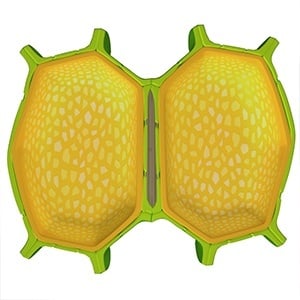
Cell lysis is the process of disrupting cell walls in order to extract and isolate proteins, so they can be analyzed and experimented upon by life science researchers. Below, we provide an overview of different cell wall types.
- Plants - Plant cell walls have a primary membrane, and may have a secondary membrane as well. The primary membrane is made mostly of polysaccharides cellulose, pectin and hemicellulose. It is flexible, which allows the plant to grow properly, yet at the same time it is sturdy enough to establish turgor pressure, which is necessary to support the plant’s stability (i.e. water inside the cell presses up against the cell wall). The secondary membrane, if present, contains lignins, which are complex natural polymers, and one of the main classes of structural materials in the support tissues of vascular plants (as well as some algae). Lignins play an important role in making the cells waterproof and supporting xylem.
- Algae - Algal cell walls are made primarily of polysaccharides, which are long chains of polymeric carbohydrate molecules composed linked by glycosidic bonds. They can also contain cellulose, mannan or xylan. In addition, some algal cell walls -- such as those of brown algae -- contain alginic acid that is capable of absorbing water, and form a kind of gum that is used by researchers in the cosmetics and food industry.
- Bacteria - Bacteria cells walls are comprised mainly of peptidoglycan, which is a polymer of amino acids and sugars. The result is a structure that looks something like a chain link fence, which is strong enough to support the cell, yet porous enough to allow particle movement. There are two types of bacteria cell walls: Gram-positive and Gram-negative. Gram staining is used to distinguish between them.
- Archea - Archea cells walls are still being researched and not as fully understood as other types of cells walls. However, what we know thus far is that many archaea contain pseudo-peptidoglycan, which is created from the assembly of surface-layer proteins (S-layers).
- Fungi - Fungal cells walls are made of the polysaccharide chitin, which is somewhat similar to cellulose, but contains acetyl-amin (nitrogen) groups rather than hydroxyl-groups. True fungi cells walls also contain glucans (glucose polymers) and proteins, which support cell wall synthesis and lysis.
Pion Technology: Designed to Disrupt Various Types of Cell Walls
At Pion, the technology we use to design our equipment allows researchers to control and modify pressure, so that they can rupture a variety of cell types – including more challenging cells such as fungi – but without damaging the intracellular materials. This results are a higher yield with fewer passes, and results that can be scaled up to manufacturing. Learn more about our groundbreaking technology here.

